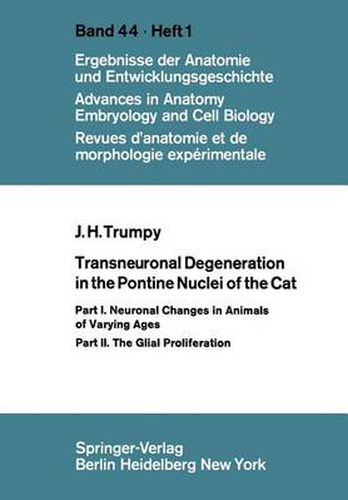Readings Newsletter
Become a Readings Member to make your shopping experience even easier.
Sign in or sign up for free!
You’re not far away from qualifying for FREE standard shipping within Australia
You’ve qualified for FREE standard shipping within Australia
The cart is loading…






This title is printed to order. This book may have been self-published. If so, we cannot guarantee the quality of the content. In the main most books will have gone through the editing process however some may not. We therefore suggest that you be aware of this before ordering this book. If in doubt check either the author or publisher’s details as we are unable to accept any returns unless they are faulty. Please contact us if you have any questions.
The present study was performed to elucidate the mechanism of a rapid nerve cell loss in the nuclei pontis described after mesencephalic lesions in young cats by Torvik (1956). He observed that hemisection of the mesencephalon caused an extensive disintegration of nerve cells in the homolateral nuclei pontis within four days after the operation. Mter lesions of the caudal part of the mesencephalon a severe neuronal loss was noted also in the inferior olive. Most of the degenerating neurons appeared to pass through a stage of pyknosis and karyorhexis before disintegration, but other types of neuronal change were also described. The changes were considered caused by deafferentation of the pontine nuclei and were regarded as a kind of transneuronal degeneration. During this degeneration an unusual type of glial proliferation was also observed. The nature of the glial pro liferation will be dealt with in Part II of this study while the neuronal changes will be studied here. A similar loss of pontine neurons had been described earlier after cortical lesions and after hemisection of the brain stem (Monakow, 1882; Borowiecki, 1911). However, the animals used by these authors were kept alive for several weeks and the acute stages of nerve cell degeneration were not studied. No clear ex planation for the changes was given. The type of nerve cell degeneration described by Torvik (1956) differs markedly from the transneuronal degeneration described in other nuclei in the cat and other animals.
$9.00 standard shipping within Australia
FREE standard shipping within Australia for orders over $100.00
Express & International shipping calculated at checkout
This title is printed to order. This book may have been self-published. If so, we cannot guarantee the quality of the content. In the main most books will have gone through the editing process however some may not. We therefore suggest that you be aware of this before ordering this book. If in doubt check either the author or publisher’s details as we are unable to accept any returns unless they are faulty. Please contact us if you have any questions.
The present study was performed to elucidate the mechanism of a rapid nerve cell loss in the nuclei pontis described after mesencephalic lesions in young cats by Torvik (1956). He observed that hemisection of the mesencephalon caused an extensive disintegration of nerve cells in the homolateral nuclei pontis within four days after the operation. Mter lesions of the caudal part of the mesencephalon a severe neuronal loss was noted also in the inferior olive. Most of the degenerating neurons appeared to pass through a stage of pyknosis and karyorhexis before disintegration, but other types of neuronal change were also described. The changes were considered caused by deafferentation of the pontine nuclei and were regarded as a kind of transneuronal degeneration. During this degeneration an unusual type of glial proliferation was also observed. The nature of the glial pro liferation will be dealt with in Part II of this study while the neuronal changes will be studied here. A similar loss of pontine neurons had been described earlier after cortical lesions and after hemisection of the brain stem (Monakow, 1882; Borowiecki, 1911). However, the animals used by these authors were kept alive for several weeks and the acute stages of nerve cell degeneration were not studied. No clear ex planation for the changes was given. The type of nerve cell degeneration described by Torvik (1956) differs markedly from the transneuronal degeneration described in other nuclei in the cat and other animals.